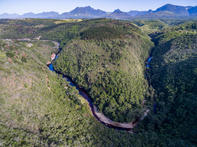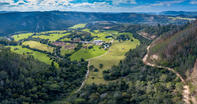A Natural Bounty of Hardwood
The coast to the East was filled with the most gorgeous, the most noble and the most valuable trees in the whole country. It was a natural bounty of hardwood that Britain was keen to harvest, but the landscape was so forbidding that no proper road could be built to access the wooden wealth.

The dreaded Kaaimansgat River Pass and the equally unpopular Duiwelskloof Mountain Pass were the only two ways to get into the Knysna forests, and all attempts to alleviate the suicidal slopes of these passes were unsuccessful. So, they called in Mr. T. Bain! Good old Tom looked at the realities of the situation and wisely decided to take a different approach.
He headed inland, towards the main face of the Outeniqua and, high up on the foothills of the range, he discovered that the fearsome Kaaimans River valley was much less formidable in its early stages. The same principle applied to the other rivers that started in the mountains and flowed down to the coast, slicing increasingly steep gorges into the high plateau.
Connect Knysna and George

Thomas Bain was already familiar with the area. He had moved to Knysna in 1860, and built many of the original roads for the straggling little settlement. Then, in 1863, Bain and his brother-in-law, Adam de Smidt, heeded the call from the local community and started working on a road that would connect Knysna and George.
The first leg of the road, the Phantom Pass from Knysna to Rheenendal, was soon completed, but here the road faltered. Bain was called on to other projects, and additional sections of the road were completed in a somewhat haphazard manner. Clearly, this was a very tough road to build.
The forests were thick, the ravines were jagged, and on-going arguments over the routing of the road destroyed the relationship between Bain and his brother-in-law. After one particularly big blow-up, they fell out permanently and never spoke personally to one another again. Yet, for all the problems they encountered, the 7 Passes Road was finally opened to traffic in 1883, twenty years after work had first begun. It was called the Passes Road because the thoroughfare had to cross several major river valleys in the course of its lateral passage from George to Knysna.
They are the Swart, Kaaimans, Silver, Touws, Diep, Hoogekraal, Karatara and the Goukamma Rivers. Building each one of these 7 passes was a fully-fledged epic, and it required the consummate skill of an experienced padmakar to bring the route to completion. As soon as it opened, the Passes Road proved a popular success, and it remained part of the main Eastern highway for over 70 years.
A Beautiful Journey
Driving the Passes Road today is an interesting experience. The road zig-zags constantly; down one valley, across the river, and up the other side, only to descend again to the next valley, and so on. Even though progress along the twisting road is quite slow by modern standards, it is very well-engineered, gently beating the contours by running in and out of every little crevice in the ravines, and the leisurely pace is part of its charm.
After all, this route was built in the days when the line of the road was dictated by the landscape, and not the other way around. Over the years, sections of the Passes road have received a tarred surface, and some sections were still getting an asphalt top as late as 2004. Nevertheless, the course of the road remains relatively unchanged from the narrow, winding route built by Bain and his captive labour force. And it is a beautiful journey.
The stands of indigenous forests, hidden in the depths of each ravine, are ravishing, and the view from the open plateau ain’t too shabby either, with the sea on one side and mountain peaks on the other. Several small towns, like Karatara (pronounced Ka-rat-ara) and Rheenendal, can be visited en route, and a detour to the old Millwood Goldfields is quite rewarding. A word of warning, though, don’t take this road if you are in a rush.
You can’t drive too fast around the tight corners, and there are few opportunities for overtaking. In particular, the final stretch to Knysna, called Phantom Pass, is still untarred and the road was badly corrugated when I drove it. A tarred access road from Rheenendal down to the N2 can be taken instead.
By David Fleminger George serves as a great base from which to explore the Garden Route's diverse scenery and many natural wonders. Head south and away from th...
George serves as a great base from which to explore the Garden Route's diverse scenery and many natural wonders. Head south and away from th... Knysna lies on the banks of a tranquil lagoon, guarded at its mouth by The Heads and overlooked to the north by the Outeniqua Mountains....
Knysna lies on the banks of a tranquil lagoon, guarded at its mouth by The Heads and overlooked to the north by the Outeniqua Mountains....